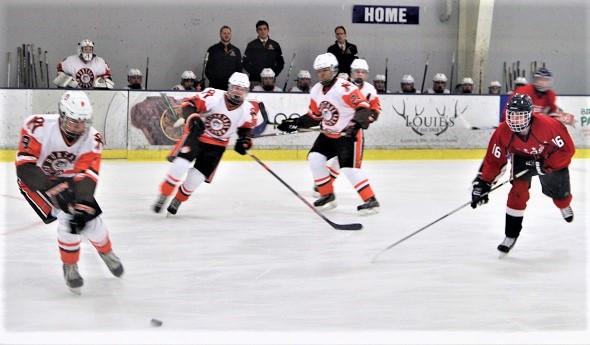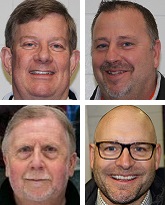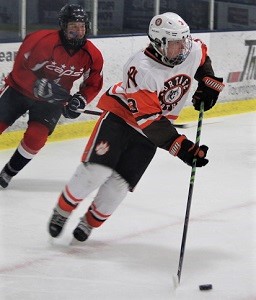
Garofalo: On-Ice Teacher and Recruiter
By
Rob Kaminski
MHSAA benchmarks editor
December 28, 2012
Something caught his eye as Allen Park’s Jim Garofalo circled the Olympic hockey rink in Salt Lake City to familiarize himself with the surroundings prior to the start of play at the 2002 Games.
“When the dimensions of a rink are laid out, everything is measured from the exact center of the ice outward,” Garofalo explains. “Usually there’s a washer or something small under the surface at center ice. All measurements are taken from there.
“Well, in Salt Lake City that year, a Canadian company was hired to prepare the sheets of ice, and they used a Loonie (common term for a Canadian $1 coin) to mark center ice. That year, the Canadians beat the United States in the gold medal game and won the Olympics on U.S. soil. I later visited the Hockey Hall of Fame in Toronto, and that Loonie is there.”
As Garofalo was getting acquainted with Canadian currency, an invitation in his mailbox back home went unanswered. At the time, MHSAA Tournament invitations were still sent by mail, so Garofalo was unaware the Association was awaiting his RSVP to accept his first Finals assignment.
“I was in Salt Lake City and had no idea. Now, of course, everything is online and by email, but that just shows how rapidly technology has progressed in the last 10 years,” Garofalo said. “So, (fellow official) Dan DiCristofaro calls and says something like, ‘Hey, do you want your state final?’ It was pretty funny; the running joke afterward was that you’ve gotta work the Olympics to get a shot at the state finals.”
Of course, that’s not the case. And, if Garofalo had it his way, all hockey officials who worked hard, persevered, paid their dues and set that as a goal would get a shot at the MHSAA Finals.
A 25-year registered MHSAA official who at one time juggled rules books for eight different hockey leagues and has worked four World Championships in addition to the Olympics, Garofalo now works only high school hockey.
“From a selfish standpoint, I suppose, I like a season that has a definite start and end to it,” says the New Boston Middle School social studies teacher, whose resume’ at one point looked like an endless Scrabble hand that included abbreviations for USA, USA Junior, Ontario, East Coast, International, International Independent and Central Collegiate hockey leagues in addition to the MHSAA.
“Being a teacher, there’s so much about the high school game that fits into education,” said Garofalo, now in his 10th year with the New Boston Huron District. “There’s so much to learn, and to help people learn at this level, from a playing and officiating standpoint.
“The people who officiate high school hockey are dedicated to improving, and as a veteran there’s an opportunity to help them learn and advance,” he says. “And, the coaches deserve kudos too. They are usually more professional and ask questions more properly than at other amateur levels. The reason is a direct result of them being accountable. They’ve got to answer to their principal or athletic director. Who are the junior and community league coaches accountable to? No one.”
 And, there’s another allure to the school game compared to which other levels pale.
And, there’s another allure to the school game compared to which other levels pale.
“The atmosphere of high school hockey is better than any other amateur level,” Garofalo says. “You go do a game at Trenton, and there’s a band. How many hockey games do you go to where there’s a band? Detroit Catholic Central and Birmingham Brother Rice have their cheering sections. It’s just a great atmosphere.”
It’s a scene that would surely help maintain the roster of younger, driven hockey officials. The trick is getting them there, according to Garofalo, one of the MHSAA’s biggest proponents for advancement and recruitment of officials.
Part of the issue is the oversaturation of games that fill Mite, Midget and other amateur schedules. Those who simply want a paycheck are never at a loss for work as long as they know how to skate.
“Hockey is unique because high school hockey is in progress at the same time as USA Hockey. An official can get twice the pay at a Bantam/Midget doubleheader than they can for one high school game,” Garofalo said. “The trouble is, who is instructing them? Who’s helping them to develop?”
To that end, Garofalo, DiCristofaro and the rest of the Northeast Hockey Referees Association established a $500 college scholarship. The recipient must be a high school hockey player who is officiating games in USA Hockey. Once they graduate from high school, many join the Association to work high school hockey.
Garofalo also offers other recruiting initiatives. In the Michigan Interscholastic Hockey League most schools play JV/Varsity doubleheaders, where the officials often let a linesman work a game at referee, while the experienced referee observes.
“At events like the Trenton Showcase, if we divide the fees differently we could get more officials involved,” he suggests. “We can do four-person crews to get our good young people some varsity experience as linesmen, and move some of our experienced linesmen to referee on the same crew with some of the top referees.”
It’s the kind of continual teaching that perpetuates the quality of officiating, and it takes time. The goal is to have the officials ready to perform when they hit the ice.
“If I put you out there to referee or pull lines, I set you up to succeed,” Garofalo says. “If I put people in too soon, I’ve set them up to fail, which leads to them leaving the game, and I haven’t done my job.”
The expectations and production of teacher and student must mesh for the system to work as intended. It requires patience as officials strive to climb the ladder, a bit of a lost art in today’s society.
“The culture of newer officials today is different. It’s a culture of immediate gratification,” says Garofalo. “Very few want to hang around eight to 10 years as a linesman before they referee, or move up. There are some very good officials who leave each year, because they haven’t become a referee, or haven’t got a tournament assignment.”
At the MHSAA Finals, Garofalo and DiCristofaro assist Jim Gagleard and the Livonia Ice Hockey Officials in heading up the off-ice officials. The inclusion and experience of such officials serves as a motivational tool which leads to improvement and retention. He also believes a four-person system in the MHSAA tournament would not only afford more qualified officials an opportunity for postseason assignments, but also provide better ice coverage as the sport’s speed has increased dramatically.
Not everyone can reach the summit, no matter the level. Even Garofalo himself, who once entertained dreams of skating in the NHL.
“The NHL looked at me a bit, but when I was at that age, it seemed all of the other linesmen were in their prime,” he said. “It is what it is.”
But, for a guy who began officiating at age 15 just to help pay for his hockey equipment, things have turned out quite well. In addition to the 2002 Olympics, Garofalo worked the Women’s World Championships in 1990, and the Men’s Worlds in Switzerland (1998), Norway (1999) and Germany (2001), working the Gold Medal game in 1998 and 1999. He’s been a fixture at the MHSAA tournament during the last dozen years.
“My wife, Mary Beth, says, ‘Wherever you go, you know someone.’ I owe that to officiating; the places I’ve gone and the people I’ve met,” Garofalo said. “It’s taken me all over the country instructing, and even overseas for some assignments. I can’t help but know people. It’s a people business.”
It might seem odd for Garofalo to even utter those words, describing the people-person this once shy kid has become. That’s one of the many rewards officiating delivers which is more valuable than any top-level assignment or game fee.
“I was quiet when I was younger. Well, when a coach is going crazy and yelling, you’ve got to speak for yourself. You learn conflict resolution,” Garofalo says, continuing as if he wrote the book on it. “‘Coach, get off the bench, quit screaming, and I’ll explain what I saw and why I called it the way I did. Then , if you have a question, I’ll answer it.’ You learn to communicate with people who don’t always agree with you.”
Then, there are the memories. Memories won’t buy a thing, but they go a long way in making 25 years on the ice, thousands of miles on the road, and countless hours away from home worth a million bucks.
“I worked 25 years for the IHL and AHL, and two years ago at the end of the regular season I was doing a Grand Rapids Griffins game. During the game, I told Brad May, ‘I’m done,’” Garofalo recalls, confiding in the gritty enforcer and one-time Stanley Cup champion who had more than 1,000 NHL games under his pads.
“At the end of the game, every guy and coach skated to me and shook my hand. Then Brad May says, ‘I heard you once worked the Olympics. It was an honor to be on the ice with you,’” Garofalo reveals, shaking his head. “Brad May said that to me.”
PHOTO: Jim Garofalo (center) officiate an NHL game. The Allen Park resident also has worked the Olympics.
NOTE: This is the sixth installment in the series "Making – and Answering – the Call" detailing the careers and service of MHSAA officials. Click the links below to view the others.

CAAC, SW Teams Find Home in New League
By
Pam Shebest
Special for MHSAA.com
January 21, 2020
Two struggling hockey leagues found a perfect match, thanks to the behind-the-scenes work of commissioners, athletic directors and coaches.
 The Capital Area Activities Conference, a multi-sport league, had just four hockey teams.
The Capital Area Activities Conference, a multi-sport league, had just four hockey teams.
The Southwest Michigan High School Hockey League was down to five.
Merging the two leagues was a no-brainer for all involved.
“We learned (the CAAC) was a small league like us,” Portage Northern athletic director Chris Riker said. “It’s tough to have a league with just five teams. By putting our two leagues together, and we had already played a lot of those teams, it just made a lot of sense.”
The new 10-team league, called the South Central High School Hockey League, is bringing a new excitement to both areas and came together very smoothly in less than a year.
Forming a new league boiled down to one thing: “survive and thrive,” said Randy Allen, a former MHSAA assistant director and retired CAAC commissioner.
“I’m tickled pink, and I give high marks to the coaches and athletic directors.”
The league is divided into the Central and South divisions, with five teams in each.
Most teams in the league are co-op teams with Jackson Lumen Christi in the Central and Mattawan, Portage Central and Portage Northern in the South the only teams made up of students from one school.
Other teams in the Central Division are the Capital City Capitals (DeWitt, Lansing Catholic, Mason, St. Johns), Mid-Michigan Marauders (Holt, Grand Ledge, Eaton Rapids, Portland, Potterville), East Side Stars (East Lansing, Williamston, Haslett, Bath, Laingsburg) and Okemos (with Fowlerville).
 Co-op teams in the South are the Kalamazoo Eagles (Gull Lake, Battle Creek Harper Creek, Battle Creek Pennfield, Paw Paw, Parchment, Plainwell) and Kalamazoo United (Loy Norrix, Kalamazoo Central, Hackett Catholic Prep).
Co-op teams in the South are the Kalamazoo Eagles (Gull Lake, Battle Creek Harper Creek, Battle Creek Pennfield, Paw Paw, Parchment, Plainwell) and Kalamazoo United (Loy Norrix, Kalamazoo Central, Hackett Catholic Prep).
The first big showcase event featuring all 10 teams is set for Friday and Saturday at Wings West in Kalamazoo.
“One of the other cool things about this new league is we’re bringing them all together for the ‘Annual Youth Hockey Fights for Autism’ at Wings West Feb. 15, and all 10 teams will be playing,” said Frank Noonan, commissioner of the old SWMHSHL and now commissioner of the new league.
Riker said the new league “creates some excitement the way we structured the season with playing in your division and playing crossover games.
“We’re going to have a big championship game where the two No. 1 teams play each other, the second-place teams meet and so on (Feb. 22 at Wings West).”
There are other benefits as well, Noonan said.
“The best thing for hockey in the area is they have set opponents they’re going to play every year and, for the kids who earn (end-of-season) awards, it means more,” he said.
“There are 10 teams competing for the awards rather than our typical six-team old division, so it’s more prestigious, more of an honor to win an award in the new league.”
MHSAA Assistant Director Cody Inglis, who took over administration of hockey for the Association when Allen retired in 2014, put Riker – a member of the MHSAA’s Representative Council – in touch with Allen. The two jump-started talks last March.
One key was getting the Eagles to become a school-based team rather than a club one.
“Karyn Furlong (Gull Lake athletic director) was willing to jump on and sponsor the Eagles,” Riker said. “She did all the leg work in getting the schools on board.
“The Eagles organization also deserves a lot of recognition for saying, hey, we’ve been in this club status and now we’re willing to come in and be a school sport.
“Now they have the opportunity to play in the state tournament, which they’ve never had.”
The MHSAA Semifinals and Finals are set for March 12-14 at USA Hockey Arena in Plymouth.
Allen, who went on to serve as commissioner of the CAAC until retiring at the start of this school year, first floated the idea of merging the two leagues to coaches from his conference.
“They were all in favor of it,” he said. “(Inglis) talked with (Riker), and we met to talk.
 “At the athletic directors conference (in March 2019), we kept inching closer to forming a new league. We did not hear one word of objection through the entire process. We had 110-percent backing.
“At the athletic directors conference (in March 2019), we kept inching closer to forming a new league. We did not hear one word of objection through the entire process. We had 110-percent backing.
“After everybody covered all the bases, we made it final and came up with the official name.”
Allen said the new league has “great leadership from the athletic directors and (Noonan), who took the lead on everything.”
He added that one perk of the new league is getting officials together. “Now we get officials to be part of one overall group, and there is a possibility of mentoring,” Allen added.
Capital City Capitals coach Travis Van Tighem likes the new league.
“It’s great to get some more natural rivals,” he said. “Our league got to be so small we played a lot of other (non-league) teams or showcase games.
“When more games have meaning or some substance to them, you can see kids growing and there are some natural rivalries that it creates, so it’s exciting.”
Travel is not a problem, Van Tighem added.
“For us in Mid-Michigan, it you go outside the Lansing area, it’s going to be an hour anyway. So coming to Kalamazoo, it’s an hour 20 or hour 15, but if we go anywhere else, except for Jackson, it’s going to be at least an hour,” he said.
“Athletic directors and coaches got together, and it really came together nicely. It’s been great so far.”
Other league facilities besides Wings West are Optimist Ice Arena (Jackson), Summit Sports and Ice Complex (Dimondale) and Suburban Ice (East Lansing).
 Pam Shebest served as a sportswriter at the Kalamazoo Gazette from 1985-2009 after 11 years part-time with the Gazette while teaching French and English at White Pigeon High School. She can be reached at [email protected] with story ideas for Calhoun, Kalamazoo and Van Buren counties.
Pam Shebest served as a sportswriter at the Kalamazoo Gazette from 1985-2009 after 11 years part-time with the Gazette while teaching French and English at White Pigeon High School. She can be reached at [email protected] with story ideas for Calhoun, Kalamazoo and Van Buren counties.
PHOTOS: (Top) Portage Northern and Capital City face off in an SCHSHL crossover Jan. 9 at Wings West. (Middle) Clockwise from top left: Frank Noonan, Chris Riker, Travis Van Tighem and Randy Allen. (Below) Northern’s Nolan McCarthy (3) charts his next move with the puck. (Photos by Pam Shebest.)

